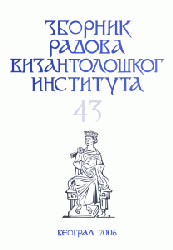Slikari zadužbina Lazarevića
Painters of the Endowments of the Lazarevic Dynasty
Author(s): Tatjana StarodubcevSubject(s): Fine Arts / Performing Arts
Published by: Vizantološki institut SANU
Keywords: painter; endowment; Lazarevic dynasty; church;
Summary/Abstract: Churches erected after the death of the last emperor of the Nemanjic dynasty raise the question of the identity of the painters who worked for the rulers in the north of the formerly vast state territory, namely in Ravanica, established by Prince Lazar, in Ljubostinja, the memorial of Princess Milica, and in Resava, raised by Despot Stefan. The Ascension Church in Ravanica was adorned with paintings on three occasions, the decoration being finally completed between 1384 and 1387. The dome was decorated by a painter of modest talents, possibly a local craftsman (fig. 1). In the second group were masters with apprentices educated in workshops in which the adherence to the classicist ideal was demanded. The artistic treatment of three of them is recognizable in the Church of Christ-Sophia, called Old Metropolis, in Voden, today Edessa, painted between 1375 and 1385 (figs. 2-3, 4-5, 6-7). The third group comprised only two artists, both of them trained in the workshops that cherished the classical heritage, who seem to have taken part in the decoration of the catholicon of the Monastery of Pantocrator on the Mount Athos, painted between 1360-1370 (figs. 9-10, 11-12). Judging by the few remaining frescoes in the narthex, it was embellished by two painters who had a propensity to a somewhat pronounced expressivity (figs. 14-15); it is possible that they joined the guild after the completion of the work in Pantocrator Monastery. The Dormition Church in Ljubostinja was not adorned by one single group of painters, either. The dome and pendentives of the naos were decorated first, in the eve of the Battle of Kosovo (1389), whereas the paintings of the church and the narthex date from the time after the death of the founder, probably between 1406 and 1408. For the embellishment of the dome of her church, Princess Milica engaged a moderately gifted painter (fig. 16) who wrote a few inscriptions in Greek; this may be interpreted as an indication of his Byzantine origin. His work was interrupted and his paintings were plastered over, and another group of painters created new frescoes on this new layer. The few preserved paintings allow only for a partial identification of the artistic hands of different painters. It may be assumed with some probability that one whose works are preserved in the southern choir and in the lower zone of the naos decorated the whole church with a colleague of his (figs. 17-18). The remaining frescoes in the lower registers of the narthex do not display any major divergences which would point to different hands. They were probably made by the painter Macarios, who signed his name in the narthex above the lunette of the door leading into the naos (figs. 19-20). This painter is usually identified with the homonymous monk, brother of the Metropolitan John, painter from Zrze...
Journal: Зборник радова Византолошког института
- Issue Year: 2006
- Issue No: 43
- Page Range: 349-393
- Page Count: 43
- Language: Serbian

